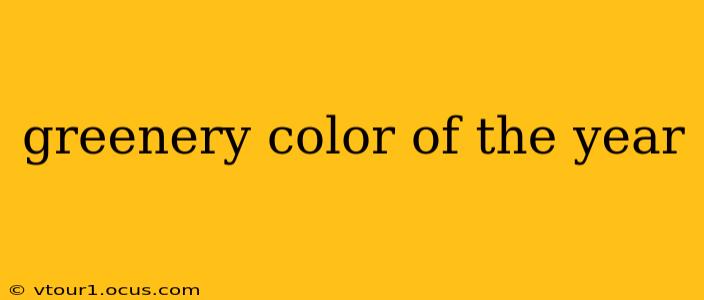Pantone's Color of the Year announcement always generates considerable buzz, and 2017's choice of Greenery (Pantone 15-0343) was no exception. This vibrant, yellowish-green hue resonated deeply with designers, marketers, and consumers alike, sparking a wave of influence across various industries. But what made Greenery so significant, and what is its lasting legacy? Let's delve into the details.
Why Was Greenery Pantone's Color of the Year 2017?
Pantone's selections aren't arbitrary. They reflect the global zeitgeist, identifying colors that capture the mood and aspirations of the time. Greenery, with its association with nature, renewal, and vitality, perfectly embodied the yearning for rejuvenation and connection to the natural world that characterized 2017. In a time of increasing technological advancements and societal anxieties, Greenery offered a soothing, optimistic counterpoint.
What Does Greenery Symbolize?
Greenery's symbolism is rich and multifaceted. It represents:
- Nature and Renewal: The color evokes lush landscapes, fresh growth, and the promise of spring.
- Balance and Harmony: Its calming effect promotes feelings of peace and tranquility.
- Energy and Vitality: The bright, optimistic shade instills a sense of vibrancy and life.
- Growth and Progress: Greenery suggests forward momentum and positive change.
This multifaceted symbolism made it easily adaptable across various applications, from fashion and interior design to marketing and branding.
How Was Greenery Used in Different Industries?
Greenery's versatility allowed for its widespread adoption across several sectors:
- Fashion: The color appeared in clothing, accessories, and footwear, often paired with neutrals or complementary shades.
- Interior Design: Greenery brought a refreshing touch to homes and workplaces, featured in paint, textiles, and décor.
- Marketing and Branding: Companies leveraged Greenery in their logos, packaging, and marketing materials to convey feelings of freshness, naturalness, and sustainability.
- Graphic Design: Greenery provided a vibrant and versatile hue for websites, brochures, and other design elements.
What Colors Complement Greenery?
Greenery's versatility means it pairs well with a wide range of colors. Some popular complementary choices include:
- Neutrals: Shades of beige, gray, and cream create a balanced and sophisticated look.
- Warm Tones: Pairing Greenery with warmer hues like terracotta or mustard yellow creates a cozy and inviting atmosphere.
- Cool Tones: Pairing it with blues and purples adds a refreshing contrast.
What Are Some Similar Colors to Greenery?
Several colors share similarities with Greenery, offering alternative choices:
- Lime Green: A brighter, more acidic version of Greenery.
- Celadon: A softer, more muted green with a bluish undertone.
- Olive Green: A darker, more earthy shade of green.
Is Greenery Still Relevant Today?
While Pantone declares a new Color of the Year annually, Greenery's influence persists. Its inherent symbolism of renewal and connection to nature remains timeless, making it a continuously relevant and popular color choice in various design applications.
Conclusion
Greenery's reign as Pantone's Color of the Year 2017 showcased its powerful influence on design and culture. Its enduring appeal lies in its ability to evoke positive emotions and symbolize growth, harmony, and connection to the natural world. While the yearly color trends shift, Greenery’s legacy remains a testament to the power of color in shaping our perceptions and experiences.
